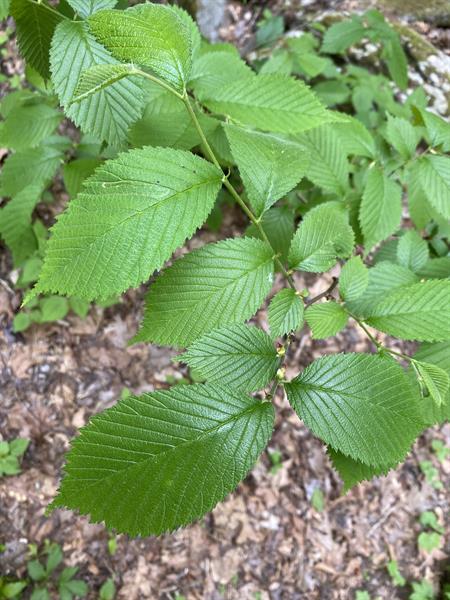
Origin/Endemic status: Native
Taxonomy Comments: It now appears that U. americana (in the broad sense) is a polyploid complex, with tetraploids throughout its distribution and diploids south of the glacial maximum (Whittemore & Olson 2011; Whittemore et al. 2021). These two entities are genetically strongly differentiated (and so far as is known, do not form hybrids in the wild when growing in proximity) and warrant taxonomic status.
Other Comments: Ascomycetous fungi, Ophiostoma ulmi and O. novo-ulmi, are the cause of the Dutch Elm disease. In our area, the effects of the disease appear to have been variable, with less impact southwards and in natural populations (as compared to suburban or urban plantings).
Synonymy: = Kurz & Godfrey (1962); = Ulmus americana L. – S, S13; < Ulmus americana L. – Ar, C, F, FNA3, G, GrPl, GW2, Il, K1, K3, K4, Mex, Mi, NcTx, NE, NY, Pa, RAB, Tat, Tn, Tx, Va, W, WH3, WV
Wetland Indicator Status:
- Atlantic and Gulf Coastal Plain: FAC (taxonomic split from wetland indicator species)
- Eastern Mountains and Piedmont: FACW (name change)
- Great Plains: FAC (taxonomic split from wetland indicator species)
- Midwest: FACW (taxonomic split from wetland indicator species)
- Northcentral & Northeast: FACW (taxonomic split from wetland indicator species)
Heliophily: 5
Hover over a shape, letter, icon, or arrow on the map for definition or see the legend.
 © Paul Marcum source | Original Image ⭷
© Paul Marcum source | Original Image ⭷ © Paul Marcum source | Original Image ⭷
© Paul Marcum source | Original Image ⭷ © Paul Marcum source | Original Image ⭷
© Paul Marcum source | Original Image ⭷ © Alan Weakley source | Original Image ⭷
© Alan Weakley source | Original Image ⭷ © Alan Weakley source | Original Image ⭷
© Alan Weakley source | Original Image ⭷ © Paul Marcum source | Original Image ⭷
© Paul Marcum source | Original Image ⭷ © Paul Marcum source | Original Image ⭷
© Paul Marcum source | Original Image ⭷ © Paul Marcum source | Original Image ⭷
© Paul Marcum source | Original Image ⭷ © Paul Marcum source | Original Image ⭷
© Paul Marcum source | Original Image ⭷Feedback
See something wrong or missing on about Ulmus americana var. americana? Let us know here: (Please include your name and email if at all complicated so we can clarify if needed.)
Cite as...